What is Superficial Venous Reflux Disease (Saphenofemoral Reflux)?
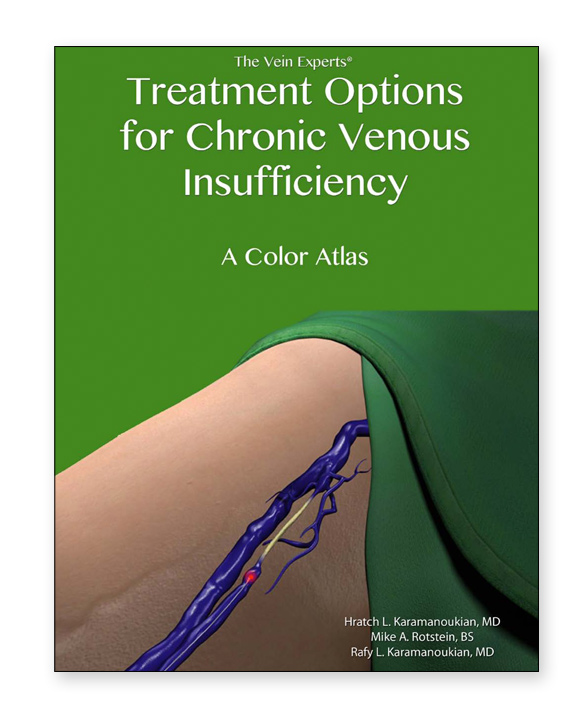
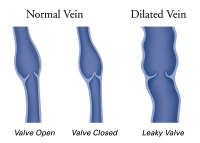 If you experience aching, pain, heaviness, tiredness, fatigue, itching, burning, cramping, throbbing and swelling in your legs and have varicose veins, you may be suffering from superficial venous reflux disease. This condition is also called venous insufficiency.
If you experience aching, pain, heaviness, tiredness, fatigue, itching, burning, cramping, throbbing and swelling in your legs and have varicose veins, you may be suffering from superficial venous reflux disease. This condition is also called venous insufficiency.
Superficial venous reflux can also cause symptoms in patients who have no obvious varicose veins. This means that there are patients who have all of the symptoms noted above without obvious varicose veins who may have this condition. They come in for evaluation because they have aching and pain in the legs, heaviness of the legs, tired legs, fatigue of the legs at the end of a work day, cramping and throbbing of the legs, or simply with leg swelling and restless legs.
Approximately 25 million Americans suffer from superficial venous reflux disease. Superficial venous reflux disease is not limited to unsightly varicose veins. One can have superficial venous reflux disease alone, superficial venous reflux disease associated with varicose veins, or varicose veins without venous reflux disease.
Longstanding untreated venous insufficiency could result in trophic changes in the skin - brown discoloration and pigmentation, hyper (too much) pigmentation or hypopigmentation (too little pigmentation) of the skin in the lower legs, and circumferential scarring of the lower legs - called lipodermatosclerosis. Some unfortunate patients will develop the worse complication, which is the development of venous stasis ulceration! It is imperative to intervene and treat venou insufficiency, especially if you have symptoms or if you have already developed skin changes.
Watch this NEW VIDEO about superficial venous reflux disease by Dr. Karamanoukian:

Venous reflux or venous insufficiency develops when the valves that usually keep blood flowing out of your legs become diseased and don't function as one-way valves. The blood 'refluxes' back into the legs. In essence, it is like gastroesophageal reflux disease when acid in the stomach goes the wrong way - instead of moving down into the small intestine, it refluxes into the esophagus, causing acid reflux symptoms - epigastric discomfort, esophageal stricture and esophageal ulceration. Venous reflux is venous blood being pushed back into the legs, instead of it moving towards the heart and lungs for proper oxygenation.
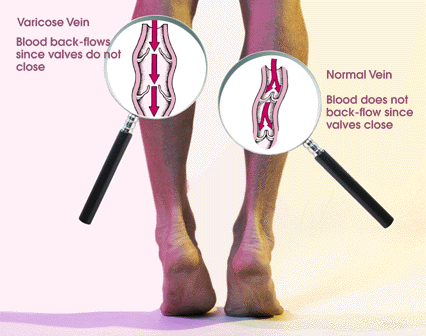 The main treatment alternative for superficial venous reflux disease is to re-route blood flow through healthy veins. The idea is to ensure that blood in the superficial venous system, namely the great saphenous vein and lesser saphenous vein and their tributaries drain towards the heart.
The main treatment alternative for superficial venous reflux disease is to re-route blood flow through healthy veins. The idea is to ensure that blood in the superficial venous system, namely the great saphenous vein and lesser saphenous vein and their tributaries drain towards the heart.
Traditionally patients diagnosed with venous reflux would undergo painful vein stripping and ligation surgery. Ligation of the veins at the level of the groin would prevent blood from refluxing into the great saphenous vein. Additionally, stripping the great saphenous vein would prevent the blood from refluxing into this vein. The thought was that ligation and stripping was a "belt and suspenders" way of treating venous reflux disease. That is, tighten the belt at the groin (ligation) and strip the great saphenous vein ("suspenders").

Unfortunately, "ligation and stripping" would limit routine activities and preclude patients to return to work for 6-8 weeks, on average. More commonly, women recall the past when their aunts or mothers spent weeks and often months out of work, and worst, being wrapped from groin to ankle with ace bandages and support hose. Today, traditional vein stripping surgery is relegated to the history books. Unless there is a technical reason not to perform VNUS Closure or endovenous laser obliteration of the great or lesser saphenous veins (EVLT), most patients are good candidates for these procedures if they have symptoms that suggest venous reflux disease and Duplex studies that support this clinical diagnosis.

image of saphenofemoral junction where reflux causes blood to back into the long (great) saphenous vein (LSV). FV is the femoral vein, which a deep vein. The sapheonofemoral junction is indicated by SFJ. Image taken from gvg.org.uk on January 10, 2009.
Based on a large body of published literature, the American College of Phlebology has published that great saphenous vein reflux is the most common underlying cause of significant varicose veins. The most most durable treatment has historically been ligation and stripping of the great saphenous vein. Thermal radiofrequency ablation with VNUS Closure and EVLT, having been used to treat hundreds of thousands of patients in the last decade with excellent long term results "should now be accepted as the treatment of choice for venous insufficiency of the great saphenous vein".
Now, patients can be treated with the VNUS Closure Procedure or the EVLT Never Touch VenaCure proceudre - minimally invasive alternatives to painful vein stripping surgery. VNUS Closure FAST utilizes radiofrequency energy to obliterate the saphenous veins and EVLT Never Touch utilizes a 'gold jacket' tip to ablate the saphenous veins with laser energy. The EVLT Never Touch is the latest laser technology to obliterate the saphenous veins with minimal discomfort and significant reduction in bruising in the post procedure period and quick return to fucntion. Typically, patients return to work the following day. Some self employed patients elect to return to work immediately. The only restriction is to not lift anything heavier than 30 pounds for 2 days, until patients return for a follow-up appointment and Doppler ultrasound scan.
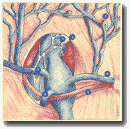
Saphenofemoral junction image taken from www.phlebologia.com
Saphenofemoral venous reflux disease occurs at the level of the groin with deep venous blood refluxing into the great saphenous vein. The great saphenous vein courses from the groin to the ankle along the medial aspect of the lower extremity. Saphenopopliteal venous reflux is reflux at the level of the popliteal fossa (back of the knee) from the popliteal vein into the lesser saphenous vein - this vein courses in the back of the thigh and leg. Perforator venous reflux occurs throughout the lower extremity and at the level of the thigh, leg and ankle (see section on perforator veins).
The Vein Treatment Center is a National Center of Excellence for Vein Disorders. Dr. Hratch Karamanoukian is listed in the 'Guide to America's Top Surgeons' in 2008 to 2014 by the Consumers Research Council of America. VeinsVeinsVeins.com is a highly rated and objective portal for information about VNUS Closure, EVLT, EVLT Never Touch VenaCure, varicose veins, spider veins and reticular veins. Dr. Karamanoukian was rated as 2009 to 2014 "Guide to America's Top Surgeons in Phlebology'. Phlebology is a specialty for venous disorders and venous surgery. Dr. Raffy Karamanoukian, a partner in the practice has been featured on The Doctors TV show for his contribution to foam sclerotherapy.
View a video of the EVLT Never Touch Procedure performed by Dr. Karamanoukian
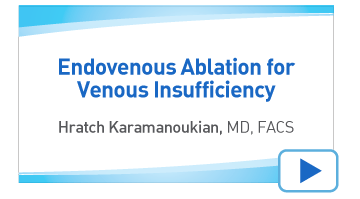
">

What is Saphenopopliteal Venous Reflux?
This is a pictorial diagram of the popliteal vein and short saphenous vein. The short saphenous vein and its tributaries courses on the outside (or lateral) aspect of the back of the leg.
In Saphenopopliteal reflux, there is reflux of venous blood flow from the popliteal vein to the short saphenous vein.

This is a picture where the short saphenous vein is followed into the popliteal vein to determine if the patient has saphenopopliteal venous reflux disease. This would mean that blood from the deep vein, namely the popliteal vein, refluxes back into the short saphenous vein of the leg. Saphenopopliteal venous reflux disease is a type of venous reflux disease that is also called venous insufficiency.
A common mistake made in the management of varicose veins is treating only the visible varicosities. If the source of the reflux is not uncovered, the treatment will fail.
In the treatment of advanced venous disorders, patients with venous reflux disease involving the saphenopopliteal junction need treatment that is directed towards eliminating this source of venous insufficiency. This means surgical ligation of this junction or the passage of endovenous catheters to close the short saphenous system .
How does the VNUS Closure Procedure fit in?
The VNUS Closure Procedure provides a less-invasive alternative to "vein stripping" by avoiding ligation (at the saphenofemoral junction or at the saphenopopliteal junction) and stripping of the great or lesser saphenous vein. A single needle puncture is used through which a tiny catheter is passed into the great or lesser saphenous vein to achieve Closure using endoluminal ablation technology.
Dr. Karamanoukian was the first physician in Western New York to perform the VNUS Closure procedure in the office setting using local anesthesia, precluding the need to place patients under general anesthesia - allowing the patient to walk out of the office and drive home within minutes of having the procedure. Almost five years after establishing the most comprehensive Vein Treatment Center, we continue to perform ALL vein procedures in the comfort of an office setting, avoiding ospitalization and risks of anesthesia and hospital associated infections.
Dr. Karamanoukian recently presented his experience in performing EVLT and VNUS Closure on individuals having venous reflux on the right and left sides at the same office setting. He is the first physician in the world to perform bilateral VNUS Closure in patients who have bilatearal disease. His experience with bilateral EVLT was presented at the 2008 American College of Phlebology meeting in Marco Island, Florida (November 2008). This allows pateints to avoid extra trips for procedures and streamlines their care and expedites their vein care. 99.5 % of our patients in a recent survey favor having their Closure procedures done in a single office encounter as opposed to two office sessions.
For more information about the VNUS Closure procedure, contact Dr. Karamanoukian at the Vein Treatment Center at 716-839-3638.
The Vein Treatment Center is a National Center of Excellence for Vein Disorders. Dr. Karamanoukian is listed in the 'Guide to America's Top Surgeons' by the Consumers Research Council of America. VeinsVeinsVeins.com is a highly rated and objective portal for information about VNUS Closure, EVLT, varicose veins, spider veins and reticular veins.
Dr. Hratch Karamanoukian uses the VenaCure Never Touch EVLT procedure. Not all EVLT is alike and the Never Touch EVLT catheter is associated with less pain and discomfort than traditional EVLT catheters. It is the best and latest laser technology with no added cost to you. Choose the Never Touch EVLT VenaCure system when you choose to have your veins ablated with laer technology.
Who performs the VNUS Closure Procedure or EVLT Never Touch Procedure?
A surgeon who has knowledge about venous disease and varicose veins. A phlebologist is typically a surgeon who has an understanding of the venous system. Dr. Karamanoukian is a member of the American College of Phlebology and a Board Certified general surgeon (American Board of Surgery, ABS). He is also a Board Certified thoracic surgeon (American Board of Thoracic Surgery (ABTS) and Board Certified in Phlebology, a specialty of venous disorders and venous surgery . Thoracic surgeons perform heart surgery, aortic and major vascular surgery of the great vessels and thoracic surgery. Dr. Karamanoukian has received recertification in general surgery (American Board of Surgery, 2009). Dr. Karamanoukian has performed thousands of vein harvesting procedures for use in coronary artery bypass operations and as such has an extensive understanding of venous anatomy and physiology. Dr. Karamanoukian's current focus is providing comprehensive vein care to his patients in a state of the art facility, the Vein Treatment Center is Williamsville, NY.
The Vein Treatment Center is a National Center of Excellence for Vein Disorders. Dr. Karamanoukian is listed in the 'Guide to America's Top Surgeons' by the Consumers Research Council of America. VeinsVeinsVeins.com is a highly rated and objective portal for information about VNUS Closure, EVLT, varicose veins, spider veins and reticular veins. www.VeinsVeinsVeins.com was recently cited as one of the top 5 best websites for vein information on the internet.
VNUS Closure, EVLT, EVLT Never Touch, VenaCure, EVLT, microphlebectomy, ambulatory phlebectomy, traditional sclerotherapy, foam sclerotherapy, laser for spider and reticular veins, ultrasound guided sclerotherapy, perforator venous reflux surgery. We were featured on The Doctors show, a nationally syndicated TV show about medical procedures. For a viewing on foam sclerotherapy click on this link:

Click the book below to read Dr. Karamanoukian's Book: Treatment Options for Chronic Venous Insufficiency
